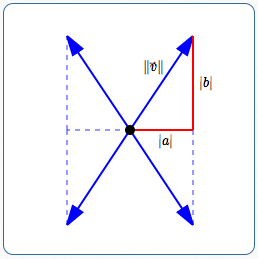 Formula For the Length of a Vector
Formula For the Length of a Vector
You may want to review prior sections:
- Introduction to Vectors
- Working With the Arrow Representation for Vectors
- Working With the Analytic Representation for Vectors
- Unit Vectors
Let $\,\overrightarrow{v} = \langle a,b\rangle\,$ be a vector.
Depending upon the signs (plus or minus) of $\,a\,$ and $\,b\,,$ the vector $\,\overrightarrow{v}\,$ is one of the four vectors shown below. (To match the diagram, suppose that $\,a\,$ and $\,b\,$ are both nonzero.)

In all four cases, the length (size, magnitude) of $\,\overrightarrow{v}\,$ is the hypotenuse of a triangle with sides of length $\,|a|\,$ and $\,|b|\,.$
Recall that $\,\|\overrightarrow{v}\|\,$ denotes the length of $\,\overrightarrow{v}\,.$ We have:
$$ \begin{align} \cssId{s7}{\|\overrightarrow{v}\|^2} &= \cssId{s8}{|a|^2 + |b|^2}\cr &\qquad \cssId{s9}{\text{(by the Pythagorean Theorem)}}\cr\cr &= \cssId{s10}{a^2 + b^2} \cr &\qquad \cssId{s11}{\substack{\text{($x^2 = |x|^2\,,$ since they have}\\ \text{the same size and sign)}}}\cr \end{align} $$Take the square root of both sides, and use the fact that $\,\|\overrightarrow{v}\|\ge 0\,.$ The result is the formula for the length of $\,\overrightarrow{v} = \langle a,b\rangle\,$:

$\overrightarrow{v} = \langle a,b\rangle\,$ is one of these four vectors:
Notes on the Vector Length Formula
In Words, to Find the Length of a Vector:
- Square the horizontal component
- Square the vertical component
- Add these squares together
- Take the square root of the sum
More compactly:
If the Horizontal or Vertical Component is Zero
If $\,a\,$ or $\,b\,$ is zero, then you don't need the vector length formula. In this case, the length is just the absolute value of the nonzero component. For example:
- $\|\,\langle 5,0\rangle\,\| = 5$
- $\|\,\langle 0,-3\rangle\,\| = |-3| = 3$
In general:
- $\|\,\langle a,0\rangle\,\| = |a|$
- $\|\,\langle 0,b\rangle\,\| = |b|$
However, the vector length formula certainly works—keep reading!
The Correct Formula for Taking the Square Root of a Square
For all real numbers $\,x\,,$ $\sqrt{x^2} = |x|\,.$ Without the absolute value symbol, it doesn't work for negative numbers! For example, $\,\sqrt{(-3)^2} \ne -3\,.$ Be careful!
Using the Vector Length Formula When a Component is Zero
Here's what happens with the vector length formula if one of the components is zero:
$$ \begin{gather} \cssId{s42}{\|\,\langle a,0\rangle\,\|} = \cssId{s43}{\sqrt{a^2 + 0^2}} = \cssId{s44}{\sqrt{a^2}} = \cssId{s45}{|a|}\cr\cr \cssId{s46}{\text{ and }} \cr\cr \cssId{s47}{\|\,\langle 0,b\rangle\,\|} = \cssId{s48}{\sqrt{0^2 + b^2}} = \cssId{s49}{\sqrt{b^2}} = \cssId{s50}{|b|} \end{gather} $$The formula works, but it's unnecessary in these simple cases.
Finding the Length of a Scaled Vector
Let $\,a\,,$ $\,b\,,$ and $\,k\,$ be real numbers. Let $\,\overrightarrow{v} = \langle a,b\rangle\,.$ Then,
$$ \begin{align} \cssId{s56}{\|k\overrightarrow{v}\|} &\ =\ \cssId{s57}{\|\,k\langle a,b\rangle\,\|}\cr &\qquad \cssId{s58}{\text{(definition of $\,\overrightarrow{v}\,$)}}\cr\cr &\ =\ \cssId{s59}{\|\,\langle ka,kb \rangle\,\|}\cr &\qquad \cssId{s60}{\text{(multiply a vector by a scalar)}}\cr\cr &\ =\ \cssId{s61}{\sqrt{(ka)^2 + (kb)^2}} \cr &\qquad \cssId{s62}{\text{(the vector length formula)}}\cr\cr &\ =\ \cssId{s63}{\sqrt{\strut k^2a^2 + k^2b^2}} \cr &\qquad \cssId{s64}{\text{(exponent law, squaring a product)}}\cr\cr &\ =\ \cssId{s65}{\sqrt{k^2(a^2 + b^2)} } \cr &\qquad \cssId{s66}{\text{(factor)}}\cr\cr &\ =\ \cssId{s67}{\sqrt{\strut k^2}\sqrt{\strut a^2 + b^2}} \cr &\qquad \cssId{s68}{\text{(property of radicals)}}\cr\cr &\ =\ \cssId{s69}{|k| \cdot \sqrt{\strut a^2 + b^2}} \cr &\qquad \cssId{s70}{\text{(since $\ \sqrt{x^2}=|x|\ $)}}\cr\cr &\ =\ \cssId{s71}{|k|\cdot \|\overrightarrow{v}\| }\cr &\qquad \cssId{s72}{\text{(the vector length formula)}} \end{align} $$So: $$\|k\overrightarrow{v}\| = |k|\cdot \|\overrightarrow{v}\|$$